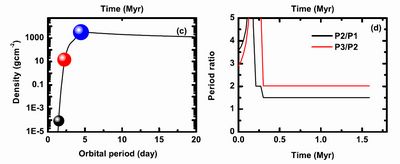On November 1, 2014, the Astrophysical Journal published a paper which reveals a formation scenario for near mean motion resonance system observed by Kepler Mission. This work was carried out by the research group of planetary sciences and deep space exploration. The results inform planetary formation theory in several respects. The Kepler Mission, launched in 2009 March, photometrically monitors a large patch of sky with sufficient precision to detect terrestrial-sized planets in potentially habitable orbits. Up to July 2014, there are 2804 planetary systems containing 4230 planetary candidates have been detected. According to the statistical results the authors note that two peaks occur at period ratios greater than the exact values of 1.5 and 2.0. It implies that amount of planet pairs are trapped near the mean motion resonances (such as 3:2 and 2:1 MMRs). How does this configuration formed and which factors affect the final configuration most? They proposed a scenario producing such configurations. It is likely that planets formed far away from the central star and they underwent orbital migration until they halt at the inner region of the disk. In this phase, three planets are trapped into mean motion resonances. Finally, tidal effects, arising from the central star, circularize their orbits. They performed more than 1000 runs by assuming a system with a solar-like star and three surrounding planets. From the statistical results, they find that low star accretion rate is propitious toward the formation of 3:2 resonance, whereas relative high star accretion rate contributes to the formation of 2:1 resonance. The speed-reduction factor of type I migration f1≥0.3 facilitates 3:2 MMRs, whereas f1≥0.1 facilitates 2:1 MMRs. Comparing the simulations results with the observation data, they noted that there exist two peaks near 1.5 and 2.0 from the numerical simulations that are consistent with the observations. Consequently, they concluded that the formation scenario proposed in this work will provide a likely explanation for Kepler candidates involved in 2:1 and 3:2 MMRs. The formation scenario is also suitable for other planetary systems, especially for systems composed of several short-period planets with low masses. 
By with for WANG Su Figure:Results for R2. Panels (a), (b), and (d) show the evolution of orbital period, eccentricity, and period ratio of the planet pairs, respectively. Panel (c) shows the final configuration of three planets. P1, P2, and P3 denote the innermost, the intermediate, and the outermost planets, respectively. The black solid curve is the density profile of the gas disk initially. The work by WANG Su and JI Jianghui have been accepted for publication in The Astrophysical Journal,available at http://iopscience.iop.org/0004-637X/795/1/85/ |
